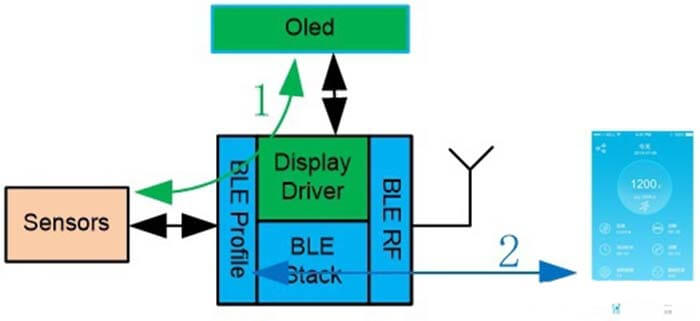The article talks about the 6 Internet of Things (IoT) wireless technology comparisons, the Bluetooth/WI-FI/ZigBee/NB-IoT/Lora/Sigfox wireless technology comparisons.
After years of dormancy, ups, and downs from concept to practice, the Internet of Things (IoT) has now taken off and the era of IoT has arrived. Some of those who started too early are already on the beach, and those who are late are afraid that they will not be able to catch the tide.
From the application side, IoT can be divided into different scenarios of IoT, such as industrial IoT, agricultural IoT, urban IoT, home IoT, and so on.
At the technical level, we usually say that there are several levels of IoT architecture, including end, tube, and cloud. On the end side, sensors, small applications, and wireless transmission are a completely small ecology, and then through wireless communication for the corresponding big data collection and cloud applications to form a large ecology of IoT (Zigbee as an example).
Take the common bracelet as an example: through the acceleration sensor, pulse sensor, blood oxygen sensor, blood pressure sensor, etc., together with Bluetooth and Bluetooth built-in MCU, you can achieve a pedometer, heart rate monitoring, and other sports or health applications.
Here the bracelet is a relatively complete small application (as shown in the Bluetooth bracelet path); finally using Bluetooth transmission and mobile phone connection can achieve sports or health data collection, to achieve big data monitoring and management.

With the commercialization of 5G, the ‘pipe’ side of the equation has basically become very fluid, with large bandwidth and low latency to meet the needs of various IoT application scenarios.
In the case of Bluetooth, 5GNR is better able to overcome the latency problem if there is an interaction between various applications and the cloud.
For example, in a home scenario, if a Bluetooth mesh network node needs to issue a network control command, which is in the form of voice, then low latency is very important.
The faster the command travels from the node to the cloud is recognized and returned to the network, the better the user experience.
On the cloud side, a lot of big companies are doing this, making platforms, making all kinds of big data, and then making all kinds of other applications based on digital.
Here, we will discuss wireless technologies on the end side of the IoT. On a macro level, this side of the end is equivalent to capillaries. There are two layers. One, it is the foundation of the IoT. Without the end, without the data, the IoT would have no foundation. The second is that there is a huge amount of it.
First, let’s look at the application scenarios corresponding to the different wireless protocols. This is the basic distinction that marks the main scenario corresponding to the protocol when it was introduced. The diagram below is a rough conceptual diagram to visualize the differences between the parties.
Secondly, let’s look at a more detailed wireless technology comparison of the characteristics.
Power consumption of wireless technology comparison
In terms of power consumption performance of wireless technology comparison, Bluetooth is the best, the best indicator on the market is 1~2uA when the RTC is dormant, this value is already basically determined by the physical characteristics of semiconductors such as PMU, pads, etc. and is generally difficult to get any smaller.
The peak at Active is basically around ten milliamps, and the average current for a 500ms broadcast is in the tens of uA.
WiFi is basically orders of magnitude higher than this, and this is a more basic judgment. The power consumption of NB-IoT, Lora, and Sigfox is basically somewhere in between.
Speed of wireless technology comparison
Bluetooth is 2Mbps and can do pass-through, do Bluetooth profile applications, audio, etc. WiFi is basically 802.11b currently used in IoT (the 802.11ah protocol for IoT is basically not used), so the highest rate is around 10Mbps.
WiFi is a protocol made for data and is currently used in control applications, where the transmission capacity is relatively poor.
The others, Zigbee, NB-IoT, Lora, Sigfox are all around 250Kbps. These protocols can basically only do very small data transmissions and cannot still do some applications like Bluetooth.
Transmission distance of wireless technology comparison
Bluetooth 5 has long-range characteristics, around 50m indoors, which is even better than WiFi in the case of high power transmission of wireless technology comparison.
Zigbee is about the same level as before BT4.2 and should be used indoors at 10 or so meters or a little more, while NB-IoT, Lora, and Sigfox are wide-area protocols with transmission distances above 1000 meters.
Networking capability of wireless technology comparison
Bluetooth’s Mesh networking is theoretically 65,000, in fact, it may be tested to hundreds or thousands of nodes at present (there are records of 10,000 points for smart luminaires).
Mesh networking is characterized by the equality of the network nodes, the collection, and control within the network can be digested within the network, while the data that needs to be uploaded to the cloud can be transmitted through a gateway (such as a smart speaker or any of the Proxy nodes) or a mobile phone.
WiFi networking is star-shaped, by routers with a dozen or dozens of nodes around them, which is not friendly for large-scale networking, as is the common industry view.
Zigbee was originally designed for industrial interconnection and has had networking capabilities from the start. Its weakness is that it requires a unique gateway to access the Internet, all networks are large in size, usually 100-200 points, and it requires a dedicated router.
Other NB-IoT, Lora, Sigfox, etc. are all star-shaped base station structures, either large or small, depending on the capacity of wireless technology comparison on the base station and the protocol specifications, which all seem to be a few K or a few dozen K at present.
Costs of wireless technology comparison
Costs of wireless technology comparison are difficult to compare directly and vary considerably between different chip specifications for the same protocol.
The cost of BLE is the smallest compared to any other protocol when comparing the same high, medium, and low-grade chips in parallel. This conclusion can also be drawn from the general feeling on the market.
Market size of wireless technology comparison
The current market size of Bluetooth, excluding audio, is more than 2 billion pieces per year, and the compound growth rate of BLE remains above 20%.
The global market for Zigbee should be 300-400 million pieces per year, NB-IoT is currently in the tens of millions of pieces per year, and Lora and Sigfox are similar.
Problems with each wireless technology comparison
The problem with WiFi is that it consumes more power, costs more, and has less networking capability.
The problem with Zigbee is that the cost is also high, the scale of the network cannot be too large to block, and there is no internet portal.
The problem with NB-IoT is that the power consumption is not as good as advertised, the cost is also high (the chip is high and the operator also charges) and the amount of data transmitted is too small.
The problem with Lora/Sigfox is that there is currently no legal identity and although the cost of the operator is eliminated, you need to build your own base station.
In summary, each protocol has its own application scenario, and it is just a case of each scenario trying to find the best way to balance the various needs as well as the costs.
At present, it seems that Bluetooth is the best in balancing power consumption, speed, cost, and networking capability for short-range wireless communication after wireless technology comparisons. Do you think so?
Besides the 6 IoT Wireless Technology Comparisons article, you may also be interested in the below articles.
What Is The Core 5G NR Technology?




